A primer on how guns work and how to use them safely.
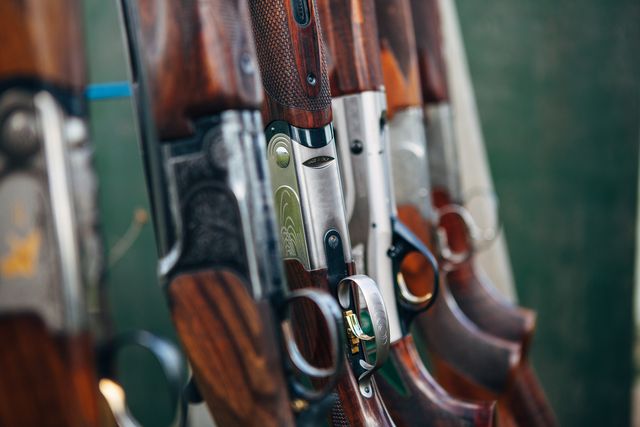
How to use a gun. Guns are a part of American life; they’re woven into our history from the time matchlock muskets armed the earliest colonies, to the Colt revolvers and Winchester rifles of the Old West, to the Glock handgun of today. Unfortunately, it seems as more time passes, gun literacy declines. We shoot more. We know less. This leads to increased gun violence and fear.
I’ve built several of my own rifles, enjoy shooting and tinkering with other types of guns, and have handled almost every major gun type built in the last 500 years. In order to better understand firearms, we’ve created this guide to how guns work, where we look at the weapon as a tool and study its history in addition to how different types function.
How Guns Work
The U.S. Bureau of Alcohol, Tobacco, Firearms, and Explosives (ATF) defines a firearm as “any weapon (including a starter gun) which will or is designed to or may readily be converted to expel a projectile by the action of an explosive.” In other words: if you have a tube and a projectile, and the projectile is designed to fly out of the tube as the result of an explosion, you have a firearm. This is a broad definition that covers everything from potato guns to fully automatic machine guns, but it provides the basic definition of what a gun is and how it works.
In the most basic sense, guns work like this: a bullet is loaded into the rear of the barrel, which is a tube connected to the firing pin. Mechanically speaking, the trigger is the catalyst that sets off a chain of events, starting with the release of the firing pin, which flies forward, striking a tiny explosive charge located in the base of the bullet. That explosion ignites the gunpowder, which is tucked inside the shell casing surrounding the bullet. The pressure change forces the bullet out of the casing and down the barrel toward the target.
Admittedly, the rapid evolution of guns makes it hard to look at them and see their basic components—a trigger, firing pin, and tubes. Today’s firearms have magazines capable of holding up to 30 or more bullets, or more than one barrel, or can fire more than one bullet per pull of the trigger. Some guns have lights, lasers, rifle scopes, bipods, and other accessories to identify a target or aid in marksmanship. It’s true that many guns operate quite simply, but as technology progresses, newer models are continually becoming more sophisticated.
Calibers and Bullet Types
You’ll hear “caliber” tossed around in any discussion of guns. This term is merely a way to identify the type of cartridge that the weapons fires.
Bullet calibers are identified two ways: by fractions of an inch, or in millimeters. The .45 ACP round used in many handguns is 0.45 inches in diameter—just under half-an-inch wide. The .22 round, .38 Special, and .500 Action Express rounds are all named for their sizes as a fraction of an inch. The 5.56-millimeter round used in an AR-15 (also expressed, in inches, as .223) is 5.56 millimeters in diameter. The nine-millimeter round is nine millimeters in diameter. And so on.
That said, a bullet’s diameter does not mean it will fit in every gun of that size, and there are many sub-varieties of ammunition. A .357 Magnum revolver bullet will not fit in a Glock pistol chambered in .357 SIG. The .22 Short round is primarily meant for pistols, while the .22 Long round is meant for rifles. This is starting to sound complicated, but what you really need to know is that, generally, a single gun can only shoot a single kind of bullet.
Different types of bullet calibers are meant to accomplish different tasks, and there are literally hundreds of bullet calibers. Some are for smaller shooters more sensitive to recoil, others are for long-range shooting, while still others are for close-range self-defense. For example, a .22 Long round is meant for small game hunting and light target practice. A .223 round, just a tiny bit wider in diameter than .22 Long has a longer range, travels at a higher velocity, and is much more lethal because of the shape of the bullet and the use of more gunpowder.
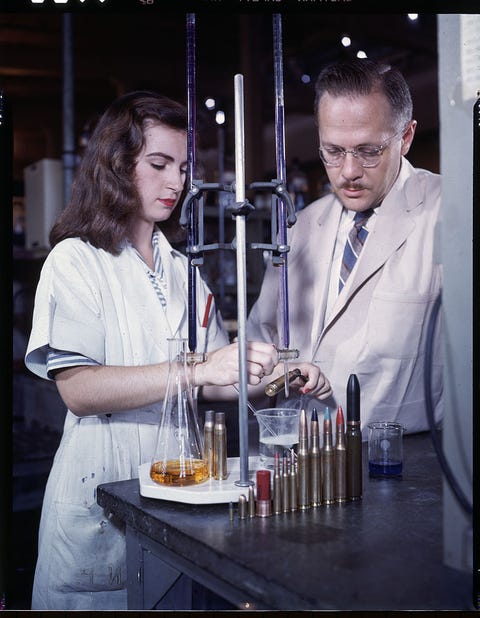
GETTY IMAGES
Bullets also have different shapes or other features to take on different tasks. Hollow-point bullets have a cavity in the nose of the bullet that allows the lead to spread outward on impact, morphing the aerodynamic bullet into a deadly, high-velocity metallic flower, creating gaping wounds. Tracer bullets are designed to allow the shooter to see where his or her bullets are striking at night, and armor-piercing bullets can penetrate body armor and light steel armor. Both are generally restricted to military use. “Snake rounds,” pistol rounds that fire a spread of small metal pellets, are useful for killing—you guessed it—dangerous snakes at a distance.
Types of Guns
There are many kinds of guns in circulation today, but they can be divided into two categories: long guns, including rifles and shotguns, and handguns, including revolvers and pistols. As a general rule, long guns fire large-caliber rounds from long barrels and are meant to be fired from the shoulder. Handguns are smaller-caliber weapons with shorter barrels, and are meant to be fired using one or both hands.
Let’s talk about some of the most common gun types:
Bolt-action rifles

A Remington Sportsman 78 bolt-action rifle.MICHEL DELSOLGETTY IMAGES
The simplest form of firearm today, a bolt-action rifle, is fired by manually pushing forward a bolt, pulling the trigger, pulling back the bolt to release the empty cartridge, and pushing the bolt forward again to load a fresh cartridge. Because of their manual nature, bolt-action guns are accurate but slow to fire. Bolt-action rifles hold between four and ten bullets in an internal or detachable magazine. Examples of a bolt-action rifle include the Remington 700 and Howa 1500.
Lever-action rifles

These rifles date back to the 19th century and are often seen in Western films. A pull of a lever attached to the rifle loads a fresh bullet, the user pulls the trigger, and another pull of the lever ejects the empty cartridge and loads a fresh one. The position of the lever makes it much faster to fire than a bolt-action rifle. Modern examples include the Winchester 94 and Marlin 336.
Semi-automatic rifles
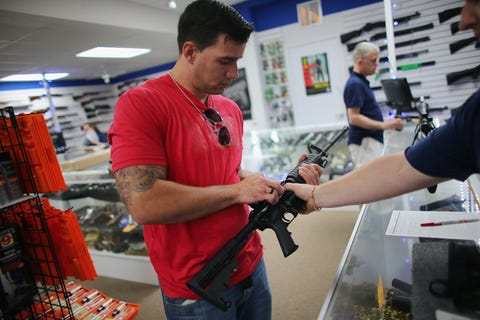
AR-15 rifle.JOE RAEDLEGETTY IMAGES
These weapons can vary greatly, but the common feature is that every pull of the trigger releases one bullet, and loading a new round is automatic. These guns are sometimes called “automatic” weapons, but in this case that term refers to the loading, not the firing.
The automatic loading process usually involves recycling some of the gun’s gunpowder gases or momentum and using it to eject the empty cartridge and load a new one. Many semi-automatic rifles have external magazines holding five to 30 rounds, which can be changed quickly to reload the weapon. Examples of semi-automatics include the AR-15 and Browning BAR rifles. (Notice the difference in appearance of both.)
Shotguns
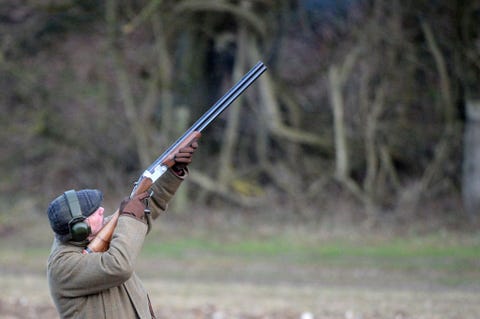
Hunter with double-barreled, break-open shotgun.GETTY IMAGES
Shotguns are large-barrel long guns that fire a large amount of small steel or lead pellets (“shot”) with each pull of the trigger rather than a single bullet. The shot flies from the barrel in a narrow cone-shaped pattern. This dispersal aids the shooter in hitting small game animals, especially those in flight, such as ducks. The size of the shot varies, with smaller birdshot less likely to kill or incapacitate a human, while larger buckshot is more useful for home defense. Shotguns can be single-shot weapons; pump-action weapons in which a single pump chambers a round; or semi-automatic. Examples of shotguns include the Mossberg 500 and Remington 870.
Revolvers
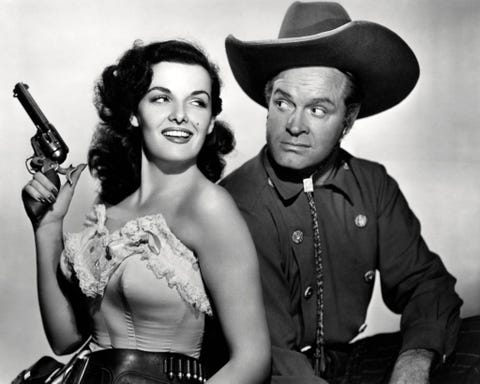
Colt Single-Action Army revolver.GETTY IMAGES
Often seen in the hands of cinematic cowboys, revolvers were the first multi-shot handguns, storing up to seven bullets in a revolving cylinder that mates with the gun barrel and firing mechanism (including the firing pin). In modern revolvers, a single pull of the trigger advances the cylinder to a fresh cartridge, pulls back the hammer, and releases the hammer to strike the primer with the firing pin, firing the handgun. Modern revolvers are considered semi-automatic weapons. Examples include the Smith & Wesson Model 686 and the Ruger GP100.
Pistols
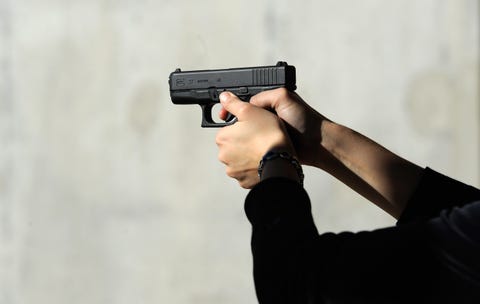
Glock 27 semi-automatic handgun.KEVORK DJANSEZIANGETTY
Pistols are handguns that do not use revolving cylinders. Although some single-shot pistols exist, most pistols these days are semi-automatic handguns that load cartridges from a detachable magazine located in the grip. Unlike revolvers, which are typically limited to up to six or seven rounds, modern pistols can carry up to 17 rounds in a magazine. Examples include the Glock 17 and the Army’s M17 Modular Handgun System, also known as the Sig P320.
Semi-automatics vs. Automatics: Where the Jargon Gets Confusing
The term “semi-automatic” has been tossed around a lot lately because so people who perpetrate mass shootings use semi-automatic weapons such as the AR-15. Semi-automatic guns fire one bullet per pull of the trigger until the magazine is empty. Fully automatic guns will fire multiple bullets as long as the trigger is depressed until the magazine is empty. Semi-automatic guns are completely legal in all 50 states. Fully automatic guns in the hands of private citizens are very rare and heavily regulated.
So-called “bump stocks” are aftermarket products that replace the normal pistol grip and shoulder stock of AR-15 and AK-47-type rifles. The replacement bump stock mechanism can fire much faster than a normal gun user can pull the trigger, dramatically increasing the gun’s rate of fire.
How are bump stocks not automatic weapons? The distinction lies in the fact that the mechanism still fires one shot for every pull of the trigger. Bump stock-equipped guns are not semi-automatic weapons in the traditional way, but the mechanism was still approved by the ATF as a semi-automatic weapon.
“Military-style” firearms is another frustratingly imprecise term. When commentators use it now, they generally mean weapons such as the AR-15 that are descendants from the kind of gun a soldier would carry, the kind that can kill many people in a short time. However, the simple, unpleasant fact is that all types of firearms currently in use by American sportsmen have been used in wars and conflicts, making all firearms “military-style firearms.”

African American “doughboys” of World War I with M1903 Springfield rifles, similar to today’s hunting rifles.GETTY IMAGES
Lever-action rifles were used during the Civil War and in the Indian Wars of the 19th century. Bolt-action rifles were used in World War I, and semi-automatic rifles were used during World War II. Revolvers and pistols were used (and are still in use) with armies around the world. Firearms such as the AR-15 are the latest in a long line of weapons that have gone from military to civilian use. Guns are just much deadlier than they used to be.
Safety Tech and Tips
All modern firearms have internal mechanisms to prevent accidental firing. The most common is the safety. At its most basic, it is a lever that, once flipped, blocks the firing pin from dropping on a cartridge primer.This content is imported from {embed-name}. You may be able to find the same content in another format, or you may be able to find more information, at their web site.https://riddler.hearstgames.com/dist/polls.iframe.html?adsfree=false&id=672ba753-2090-4f82-a28d-47121a56b4ef_4d7485b796628&type=text&question=Have%20you%20ever%20been%20to%20a%20firing%20range%3F&answer1=Yes%2C%20I%20like%20to%20practice%20my%20gun%20safety%20techniques.&answer2=Not%20yet%2C%20but%20I%E2%80%99d%20like%20to%20go.&brand=Popular%20Mechanics&siteId=a4f9566a-1fd0-484c-b731-150b9bda9ffa&adCategory=technology§ion=Military&subSection=Weapons&editor=Kyle%20Mizokami&authors=Kyle%20Mizokami&site=Popular%20Mechanics&stylesheet=https%3A%2F%2Fassets.hearstapps.com%2Fsites%2Fpopularmechanics%2Fassets%2Fcss%2Fpolls.47ffe9f.css&marketingpolls=true
Other mechanisms are less intrusive and are meant to prevent accidental discharge in the event the gun is dropped or mishandled. The Colt M1911A1 and the Springfield XD both have grip safeties, levers that must be pressed (when the gun is held properly) for the gun to fire. The Glock pistol has a safety on the tip of the trigger itself, ensuring that a finger must be on the trigger for the gun to fire.
And while we’re talking about responsible gun ownership, let’s talk about the four simple rules everyone who handles guns knows—or should know. Each rule is simple, and taken together, they’re pretty good at averting tragedy.
Rule No. 1: Always treat every firearm as though it is loaded.
Sometimes people forget a gun is loaded. Sometimes the weapon was loaded without their knowledge. If someone hands you a firearm, it is always a good idea to assume it is loaded. It is also a good idea to visually inspect the gun for a round in the chamber, even if you just saw someone else do it. (They might have missed something.)
Rule No. 2: Always keep the muzzle pointed in a safe direction.
Guns should always be pointed in a safe direction when handled. This goes for whether the gun is unloaded or loaded. Modern engineering virtually ensures today’s guns won’t go off due to a design flaw, but rule No. 2 is designed to minimize the possibility of tragedy in the event of negligence. In the event the gun does go off unintentionally, this ensures the bullet won’t accidentally hit people or pets.
Rule No. 3: Keep your finger off the trigger until ready to shoot.
This sounds blindingly obvious. The fact is, a shocking number of people new to firearms immediately find their trigger fingers gravitating to the trigger. To people new to guns, it just seems like the place where the index finger is supposed to go. Nope. It’s an easy bad habit to get into, but don’t put your finger here until you’re ready to fire. If the person holding the gun is surprised, jolted, pushed, or shoved, his or her finger could reflexively squeeze the trigger, discharging the weapon before it is properly aimed.
Rule No. 4: Know your surroundings.
Aiming a gun with eyes focused on the target, a shooter develops tunnel vision. This makes potential safety hazards between you and your target hard to spot until the very last moment. Furthermore, bullets can travel for miles beyond your target before gravity brings them down. Only shoot in areas where you know with certainty that the entire potential path of the bullet is safe. I like to go to the shooting range, for example, and these places prohibit people from moving past the firing line until safety officers give the “all clear.” Typically, they also have a built-in sand berm or other backstop to stop bullets.
Guns are inherently dangerous and must therefore be handled with extreme caution and care. The more you familiarize yourself with firearms, how they function, and best practices for safe usage, the more responsible of a gun owner you’ll become.
